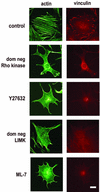Effects of rho kinase and actin stress fibers on sustained extracellular signal-regulated kinase activity and activation of G(1) phase cyclin-dependent kinases
- PMID: 12773570
- PMCID: PMC156148
- DOI: 10.1128/MCB.23.12.4283-4294.2003
Effects of rho kinase and actin stress fibers on sustained extracellular signal-regulated kinase activity and activation of G(1) phase cyclin-dependent kinases
Retraction in
-
Effects of rho kinase and actin stress fibers on sustained extracellular signal-regulated kinase activity and activation of G1 phase cyclin-dependent kinases.Mol Cell Biol. 2006 Jul;26(13):5203. doi: 10.1128/MCB.00844-06. Mol Cell Biol. 2006. PMID: 16782904 Free PMC article. No abstract available.
Abstract
We recently reported that Rho kinase is required for sustained ERK signaling and the consequent mid-G(1) phase induction of cyclin D1 in fibroblasts. The results presented here indicate that these Rho kinase effects are mediated by the formation of stress fibers and the consequent clustering of alpha5beta1 integrin. Mechanistically, alpha5beta1 signaling and stress fiber formation allowed for the sustained activation of MEK, and this effect was mediated upstream of Ras-GTP loading. Interestingly, disruption of stress fibers with ML-7 led to G(1) phase arrest while comparable disruption of stress fibers with Y27632 (an inhibitor of Rho kinase) or dominant-negative Rho kinase led to a more rapid progression through G(1) phase. Inhibition of either MLCK or Rho kinase blocked sustained ERK signaling, but only Rho kinase inhibition allowed for the induction of cyclin D1 and activation of cdk4 via Rac/Cdc42. The levels of cyclin E, cdk2, and their major inhibitors, p21(cip1) and p27(kip1), were not affected by inhibition of MLCK or Rho kinase. Overall, our results indicate that Rho kinase-dependent stress fiber formation is required for sustained activation of the MEK/ERK pathway and the mid-G(1) phase induction of cyclin D1, but not for other aspects of cdk4 or cdk2 activation. They also emphasize that G(1) phase cell cycle progression in fibroblasts does not require stress fibers if Rac/Cdc42 signaling is allowed to induce cyclin D1.
Figures








Comment in
-
Findings of misconduct in science.NIH Guide Grants Contracts (Bethesda). 2007 Jul 20:NOT-OD-07-075. NIH Guide Grants Contracts (Bethesda). 2007. PMID: 17647301 Free PMC article. No abstract available.
Similar articles
-
Disruption of the actin cytoskeleton leads to inhibition of mitogen-induced cyclin E expression, Cdk2 phosphorylation, and nuclear accumulation of the retinoblastoma protein-related p107 protein.Exp Cell Res. 2000 Aug 25;259(1):35-53. doi: 10.1006/excr.2000.4966. Exp Cell Res. 2000. PMID: 10942577
-
Stimulation of the Raf/MEK/ERK cascade is necessary and sufficient for activation and Thr-160 phosphorylation of a nuclear-targeted CDK2.J Biol Chem. 2002 Dec 6;277(49):47469-75. doi: 10.1074/jbc.M207425200. Epub 2002 Sep 30. J Biol Chem. 2002. PMID: 12359725
-
Assembly of cyclin D-dependent kinase and titration of p27Kip1 regulated by mitogen-activated protein kinase kinase (MEK1).Proc Natl Acad Sci U S A. 1998 Feb 3;95(3):1091-6. doi: 10.1073/pnas.95.3.1091. Proc Natl Acad Sci U S A. 1998. PMID: 9448290 Free PMC article.
-
Ras regulation of cyclin-dependent immunoprecipitation kinase assays.Methods Enzymol. 2001;333:127-38. doi: 10.1016/s0076-6879(01)33051-3. Methods Enzymol. 2001. PMID: 11400330 Review. No abstract available.
-
Growth control by intracellular tension and extracellular stiffness.Trends Cell Biol. 2008 Jul;18(7):347-52. doi: 10.1016/j.tcb.2008.05.002. Epub 2008 May 29. Trends Cell Biol. 2008. PMID: 18514521 Free PMC article. Review.
Cited by
-
The Rho GTPase effector ROCK regulates cyclin A, cyclin D1, and p27Kip1 levels by distinct mechanisms.Mol Cell Biol. 2006 Jun;26(12):4612-27. doi: 10.1128/MCB.02061-05. Mol Cell Biol. 2006. PMID: 16738326 Free PMC article.
-
Multifaceted role of Rho proteins in angiogenesis.J Mammary Gland Biol Neoplasia. 2005 Oct;10(4):291-8. doi: 10.1007/s10911-006-9002-8. J Mammary Gland Biol Neoplasia. 2005. PMID: 16900393 Review.
-
Rho1 regulates signaling events required for proper Drosophila embryonic development.Dev Biol. 2005 Feb 1;278(1):144-54. doi: 10.1016/j.ydbio.2004.10.022. Dev Biol. 2005. PMID: 15649467 Free PMC article.
-
Assessing the accuracy and reproducibility of modality independent elastography in a murine model of breast cancer.J Med Imaging (Bellingham). 2015 Jul;2(3):036001. doi: 10.1117/1.JMI.2.3.036001. Epub 2015 Jul 2. J Med Imaging (Bellingham). 2015. PMID: 26158120 Free PMC article.
-
The role of Lutheran/basal cell adhesion molecule in human bladder carcinogenesis.J Biomed Sci. 2017 Aug 26;24(1):61. doi: 10.1186/s12929-017-0360-x. J Biomed Sci. 2017. PMID: 28841878 Free PMC article.
References
-
- Adnane, J., F. A. Bizouarn, Y. Qian, A. D. Hamilton, and S. M. Sebti. 1998. p21WAF1/CIP1 is upregulated by the geranylgeranyltransferase I inhibitor GGTI-298 through a transforming growth factor beta- and Sp1-responsive element: involvement of the small GTPase RhoA. Mol. Cell. Biol. 18:6962-6970. - PMC - PubMed
-
- Agnew, B. J., L. S. Minamide, and J. R. Bamburg. 1995. Reactivation of phosphorylated actin depolymerizing factor and identification of the regulatory site. J. Biol. Chem. 270:17582-17587. - PubMed
-
- Amano, M., K. Chihara, K. Kimura, Y. Fukata, N. Nakamura, Y. Matsuura, and K. Kaibuchi. 1997. Formation of actin stress fibers and focal adhesions enhanced by Rho kinase. Science 275:1308-1311. - PubMed
-
- Amano, M., M. Ito, K. Kimura, Y. Fukata, K. Chihara, T. Nakano, Y. Matsuura, and K. Kaibuchi. 1996. Phosphorylation and activation of myosin by Rho-associated kinase (Rho kinase). J. Biol. Chem. 271:20246-20249. - PubMed
-
- Aplin, A. E., S. M. Short, and R. L. Juliano. 1999. Anchorage-dependent regulation of the mitogen-activated protein kinase cascade by growth factors is supported by a variety of integrin α chains. J. Biol. Chem. 274:31223-31228. - PubMed
Publication types
MeSH terms
Substances
Grants and funding
LinkOut - more resources
Full Text Sources
Research Materials
Miscellaneous
